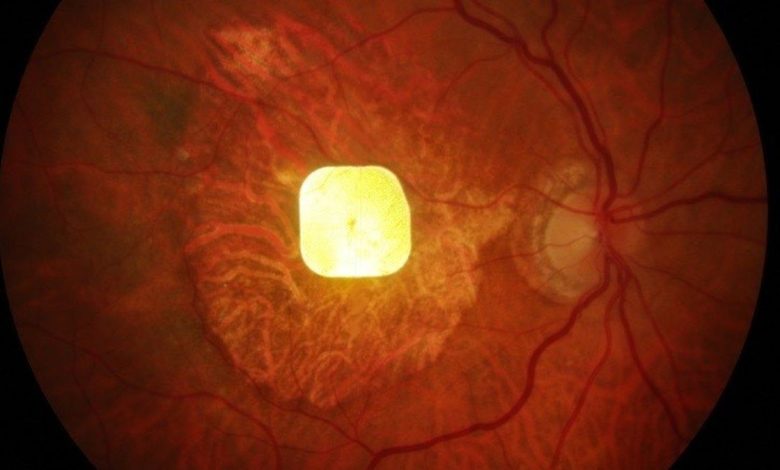Revolutionary Prosthetic Eye Chip Restores Sight — The Medical Miracle Changing Lives Forever!

In a world where blindness has long been seen as irreversible, science has delivered something extraordinary — a prosthetic eye chip capable of restoring sight to the blind. This groundbreaking innovation, blending biotechnology, microelectronics, and artificial intelligence, is redefining what’s possible in vision restoration. It’s not just an upgrade in medical technology — it’s a beacon of hope for millions worldwide who live without sight.
How the prosthetic eye chip works, the incredible science behind it, the stories of people whose lives it has transformed, and what this medical miracle means for the future of human vision.
A Glimpse Into the Future: What Is a Prosthetic Eye Chip?
The prosthetic eye chip — sometimes called a bionic eye implant or retinal microchip — is a tiny electronic device surgically implanted in or near the retina or visual cortex of the brain. Its purpose is to restore partial or even near-normal vision to people who are blind due to retinal degenerative diseases such as retinitis pigmentosa or age-related macular degeneration (AMD).
Imagine a chip smaller than a grain of rice, packed with hundreds of electrodes that can translate light into electrical signals — signals that the brain interprets as visual images. That’s the essence of this technology.
The concept might sound like science fiction, but it’s real, tested, and now — for the first time — changing lives around the world.
How It Works: Turning Light into Vision
At the heart of the prosthetic eye chip lies an astonishingly complex process — one that mirrors how a healthy human eye naturally works.
- Capturing Light
A miniature camera — often mounted on special glasses or integrated into the implant — captures visual information from the environment. - Processing the Image
The camera sends data to a small processing unit (similar to a smartphone chip), which converts the image into electrical impulses. - Stimulating the Retina or Brain
These impulses are transmitted to an implanted chip either in the retina (for retinal prosthetics) or directly into the visual cortex (for cortical implants).
The chip’s electrodes stimulate the remaining healthy cells in the retina or neurons in the brain, bypassing the damaged parts of the visual pathway. - Brain Perception
The brain interprets these signals as patterns of light, shapes, and — over time — detailed images.
With rehabilitation and practice, patients can recognize faces, navigate spaces, and even read large text.
From Darkness to Light: The Breakthrough Technologies Behind It
Several pioneering research teams have contributed to the creation of this life-changing technology. Let’s explore the most significant breakthroughs that made the prosthetic eye chip a reality.
1. The Argus II Retinal Prosthesis System
Developed by Second Sight Medical Products, the Argus II was among the first FDA-approved devices to restore functional vision.
This implant uses a small camera mounted on glasses and a microelectronic chip implanted in the eye. Early clinical trials showed that patients who had been blind for decades could perceive motion, identify shapes, and navigate around obstacles.
2. The PRIMA System by Pixium Vision
The PRIMA bionic vision system, developed in France, introduced a wireless photovoltaic chip implanted under the retina. This chip converts infrared light projected from special glasses into electrical signals that stimulate retinal neurons.
Its biggest advantage? Wireless operation, eliminating the need for connecting cables or bulky external devices.
3. The Bionic Eye System by Monash Vision Group
Unlike retinal implants, this Australian innovation targets the brain directly. The Gennaris bionic vision system bypasses the eye entirely, using a chip implanted in the visual cortex of the brain.
This opens the door for people who have lost their eyes entirely or whose optic nerves are irreparably damaged — a remarkable leap beyond previous technologies.
4. Artificial Intelligence Integration
Modern versions of prosthetic eye chips are now incorporating AI-powered image processing. These systems help interpret complex visual scenes, enhance contrast, and improve object recognition — giving users a smoother, more natural experience of sight.
The Human Impact: Real Lives Transformed
Behind every technological triumph is a human story. And the stories of those who’ve regained sight through these implants are nothing short of miraculous.
Case Study 1: Barbara Campbell — Seeing Again After 20 Years
Barbara Campbell, blind from retinitis pigmentosa, became one of the first recipients of the Argus II system. After two decades in darkness, she could once again make out light, shapes, and movement.
“The first time I saw light flickering,” she said, “I cried. It wasn’t perfect vision — but it was mine again.”
Her ability to perceive her husband’s silhouette and navigate her home restored a sense of independence she thought she had lost forever.
Case Study 2: A Young Engineer Regains His Career
In another case, a 34-year-old engineer from Germany, blinded by retinal degeneration, received a PRIMA implant. Within weeks, he was able to detect patterns and objects — enough to return to designing models on a computer screen using visual feedback for the first time in years.
Case Study 3: Restoring Hope for the Completely Blind
For patients who have lost their eyes entirely, cortical implants are offering the first real hope. In trials with the Gennaris system, volunteers reported seeing flashes of light, shapes, and even movement — a foundational step toward full artificial vision.
These stories aren’t isolated — they represent the dawn of a new era in neuroscience and biotechnology.
The Science of Healing: Why This Works
The human brain is astonishingly adaptable. Even after years of blindness, the visual cortex — the brain’s center for processing sight — often remains functional.
The prosthetic eye chip taps into this potential, “rewiring” the brain to interpret artificial electrical signals as visual input.
This ability, known as neuroplasticity, allows patients to train their brains to make sense of the visual data sent by the chip. Over time, what begins as simple light flashes can evolve into meaningful vision.
Challenges and Limitations
While revolutionary, prosthetic eye chips are not yet perfect. Patients don’t suddenly regain 20/20 vision — current devices offer limited resolution and require intensive rehabilitation. Some key challenges include:
- Low Image Resolution
Current implants offer vision similar to early black-and-white digital displays — enough to perceive outlines, movement, and light contrast but not fine detail. - Surgical Complexity
Implanting the chip requires highly specialized surgery and carries risks like infection, inflammation, or implant rejection. - Cost and Accessibility
Early prototypes can cost upwards of $150,000, putting them out of reach for many who need them most. Researchers hope that wider adoption will lower costs over time. - Brain Adaptation Period
It can take months of visual training before patients can interpret the signals effectively.
Despite these limitations, progress is accelerating rapidly — and each new generation of implants doubles or triples visual clarity.
A Leap Beyond Biology: What’s Coming Next
Scientists are already working on next-generation prosthetic eye chips that promise to go beyond simply restoring sight.
Here’s what the future might look like:
1. High-Resolution Nanochip Implants
Researchers at Stanford and the University of Sydney are developing nano-scale retinal implants that can pack tens of thousands of electrodes into a single chip — offering sharper, more detailed vision.
2. Full-Color Vision
The next frontier is color. By mimicking the way cones in the human retina process red, green, and blue light, scientists are exploring multi-spectral chips that can bring color back to artificial vision.
3. Brain-Connected Vision Networks
Using neural interface technology, prosthetic eyes could one day sync directly with cloud-based AI processors. This would allow real-time scene analysis, facial recognition, and object labeling — effectively turning the implant into an AI-enhanced eye.
4. Wireless Power and Data Transfer
Future systems aim to eliminate bulky batteries and wires entirely, using wireless inductive charging and data transmission to make implants smaller, safer, and more efficient.
5. Integration with Smart Glasses
Imagine combining augmented reality (AR) glasses with a prosthetic eye chip. Patients could overlay visual information — navigation aids, text magnification, or obstacle detection — directly into their field of vision.
The Ethics of Restoring and Enhancing Vision
As with all great innovations, the rise of prosthetic eye chips brings ethical questions.
Where do we draw the line between restoring human vision and enhancing it? If future implants can offer “superhuman” sight — seeing in infrared, zooming in on distant objects, or linking to digital databases — how will that redefine humanity’s relationship with technology?
Experts urge that while restoring vision is a moral imperative, bioethical frameworks must evolve to ensure equitable access, data privacy, and consent in the era of brain-connected devices.
The Global Race Toward a Cure for Blindness
Countries across the globe are now racing to refine and deploy this technology.
- United States & Europe: Focus on FDA-approved retinal implants and clinical trials for cortical systems.
- Japan & South Korea: Developing flexible, bio-compatible materials to improve implant longevity.
- China & India: Scaling production and affordability, aiming to make bionic vision available to millions in developing regions.
This global collaboration marks a turning point in medical innovation — one driven not by competition, but by a shared vision of ending blindness forever.
Beyond Sight: The Emotional Impact
For patients, regaining sight is more than a physical transformation — it’s emotional rebirth.
The ability to see a loved one’s face, recognize colors, or watch a sunset again often brings overwhelming joy and tears.
Rehabilitation programs often include psychological counseling to help patients adjust to the sensory overload and emotional rediscovery that comes with regained vision. Many describe it as “seeing the world for the first time — again.”
Conclusion: A New Dawn for Vision Science
The prosthetic eye chip is far more than a piece of technology — it’s a symbol of human resilience, innovation, and compassion.
It stands as proof that blindness, once considered permanent, can now be reversed — and perhaps, one day, eliminated entirely.
As research continues to refine and perfect this miraculous device, one thing is certain:
The age of sight restoration has begun.
From the laboratories of biomedical engineers to the operating rooms of pioneering surgeons, this technology is ushering in a world where light once lost can be found again — and where hope shines brighter than ever before.




